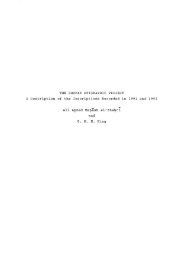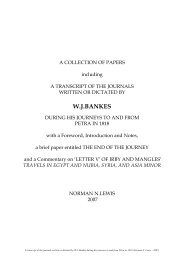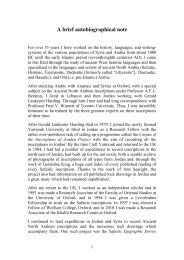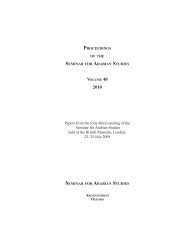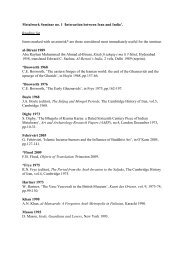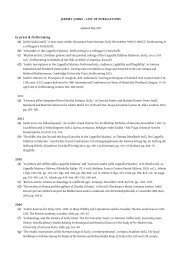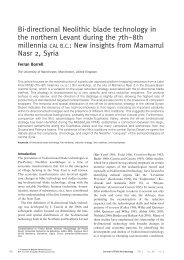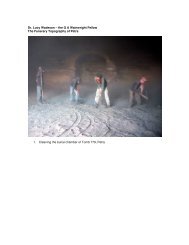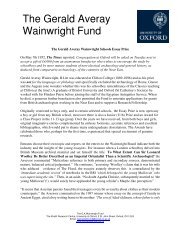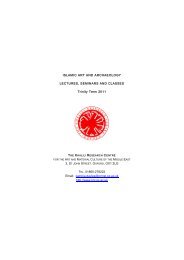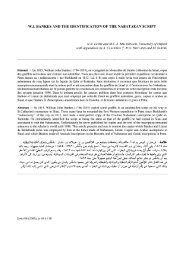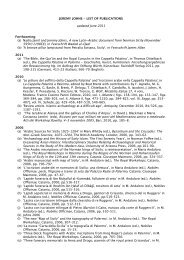Reflections on the linguistic map of pre-Islamic Arabia - Khalili ...
Reflections on the linguistic map of pre-Islamic Arabia - Khalili ...
Reflections on the linguistic map of pre-Islamic Arabia - Khalili ...
You also want an ePaper? Increase the reach of your titles
YUMPU automatically turns print PDFs into web optimized ePapers that Google loves.
et’ with various geographical variati<strong>on</strong>s. I <strong>the</strong>refore<br />
argued that <strong>the</strong> neutral term ‘Thamudic E’<br />
which had no such implicati<strong>on</strong>s was to be <strong>pre</strong>ferred,<br />
and it was under this label that Geraldine<br />
King analyzed <strong>the</strong> script and dialect. However,<br />
as a result <strong>of</strong> her study it would now be c<strong>on</strong>fusing<br />
to c<strong>on</strong>tinue referring to <strong>the</strong> script and dialect<br />
as ‘Thamudic’, and for this reas<strong>on</strong> a new name is<br />
required.<br />
43. This spelling (ie. with alif maqsw ūrah) is <strong>the</strong> <strong>on</strong>e<br />
in <strong>the</strong> Official Standard Names Gazetteer for<br />
Jordan (Department <strong>of</strong> <strong>the</strong> Interior, Washingt<strong>on</strong><br />
DC).<br />
44. Macd<strong>on</strong>ald and King, Thamudic: 437–438.<br />
45. Formerly Jabal al-Durūz (le Djebel Druze) or<br />
Jabal Hw awrān, Roman Auranitis.<br />
46. See below and, for a detailed discussi<strong>on</strong>, Macd<strong>on</strong>ald<br />
MCA. Nomads and <strong>the</strong> Hw awrān in<strong>the</strong><br />
late Hellenistic and Roman Periods: A Reassessment<br />
<strong>of</strong> <strong>the</strong> Epigraphic Evidence. Syria 70: 1993:<br />
305–310, 377–382.<br />
47. These texts were first identified as re<strong>pre</strong>senting<br />
a separate group by F.V. Winnett (A Himyaritic<br />
Inscripti<strong>on</strong> from <strong>the</strong> Persian Gulf Regi<strong>on</strong>.<br />
BASOR 102: 1946: 6). The name ‘Hasaean’ was<br />
originally suggested by R. le B. Bowen (The<br />
Early <strong>Arabia</strong>n Necropolis <strong>of</strong> Ain Jawan. A Pre-<br />
<strong>Islamic</strong> and Early <strong>Islamic</strong> Site <strong>on</strong> <strong>the</strong> Persian Gulf.<br />
New Haven, CT: BASOR Supplementary Studies,<br />
7–9: 1950: 5, 25) and taken up by A. Jamme<br />
(Sabaean and Hw asaean Inscripti<strong>on</strong>s from Saudi<br />
<strong>Arabia</strong>. Rome: Studi semitici, 23: 1966: 66). However,<br />
W.W. Müller has called for <strong>the</strong>m to be<br />
renamed ‘Hasaitic’ to <strong>pre</strong>serve <strong>the</strong> -ic/aean distincti<strong>on</strong><br />
menti<strong>on</strong>ed above (Das Altarabische<br />
und das klassische Arabisch: 26). There is no<br />
complete corpus <strong>of</strong> all <strong>the</strong> Hasaitic texts known<br />
to date, but useful collecti<strong>on</strong>s can be found in<br />
Potts DT. The <strong>Arabia</strong>n Gulf in Antiquity. 2.Oxford:<br />
Clarend<strong>on</strong> 1990: 69–85, with a good discussi<strong>on</strong><br />
and abundant references but with <strong>on</strong>ly<br />
<strong>on</strong>e figure (showing four facsimiles) and no<br />
photographs. However, <strong>the</strong>re are generally excellent<br />
illustrati<strong>on</strong>s in Livingst<strong>on</strong>e A. A Linguistic,<br />
Tribal and Onomastical Study <strong>of</strong> <strong>the</strong> Hasaean<br />
Inscripti<strong>on</strong>s. ATLAL 8: 1984: pls 85–90,<br />
although unfortunately <strong>the</strong> text <strong>of</strong> this article<br />
has been rendered unusable by numerous printers’<br />
errors.<br />
48. Eg. at Warka in sou<strong>the</strong>rn Mesopotamia (CIH<br />
699) or <strong>on</strong> <strong>the</strong> Oman Peninsula, at Mleiha in<br />
Sharja, UAE (Robin-Mulayhw a I, see Robin, Documents<br />
de l’Arabie antique, 3: 80). Note that in<br />
<strong>the</strong> same article Robin republishes, under <strong>the</strong><br />
siglum ‘Wilkins<strong>on</strong>-Mulayhw a 1’, Beest<strong>on</strong>’s trans-<br />
THE LINGUISTIC MAP OF PRE-ISLAMIC ARABIA<br />
lati<strong>on</strong> and a corrected versi<strong>on</strong> <strong>of</strong> his transliterati<strong>on</strong><br />
<strong>of</strong> a text (now lost) from <strong>the</strong> same site (see<br />
Beest<strong>on</strong> AFL. [Note <strong>on</strong> an inscripti<strong>on</strong> from<br />
Sharja]. In: Wilkins<strong>on</strong> JC. Water and Tribal Settlement<br />
in South-East <strong>Arabia</strong>. A Study <strong>of</strong> <strong>the</strong> Aflāj <strong>of</strong><br />
Oman. Oxford: Clarend<strong>on</strong>, 1977: 135, n. 6).<br />
49. See, for instance, Robin, L’Arabie antique: 118–<br />
119, or Müller, Das Altarabische und das klassische<br />
Arabisch: 25–26.<br />
50. Robin, L’Arabie antique: 136 and see <strong>the</strong> table<br />
<strong>on</strong> 137, c<strong>on</strong>tradicting his statement <strong>on</strong> pp. 118–<br />
119.<br />
51. L<strong>of</strong>tus WK. Travels and Researches in Chaldaea and<br />
Susiana. L<strong>on</strong>d<strong>on</strong>: Nisbet, 1857: 233.<br />
52. If a North <strong>Arabia</strong>n script had been native to<br />
sou<strong>the</strong>rn Mesopotamia – an area <strong>of</strong> obsessive<br />
literacy which has been explored by archaeologists<br />
for almost two centuries – <strong>on</strong>e would expect<br />
far more texts to have been found and a far<br />
greater c<strong>on</strong>sistency in <strong>the</strong> scripts employed in<br />
<strong>the</strong>m.<br />
53. It would appear that Robin’s idea <strong>of</strong> a c<strong>on</strong>necti<strong>on</strong><br />
between <strong>the</strong> Hasaitic and <strong>the</strong> Dispersed<br />
Oasis North <strong>Arabia</strong>n scripts may derive ultimately<br />
from a misunderstanding <strong>of</strong> a remark by J.<br />
Ryckmans that <strong>the</strong> script <strong>of</strong> Ja 1049 (ΩJamme,<br />
Sabaean and Hw asaean Inscripti<strong>on</strong>s: 6: Fig. 18), a<br />
rock graffito found near al-Hw asā, was in a script<br />
‘proche de certains cachets trouvés enMésopotamie’<br />
(Ryckmans J. Review <strong>of</strong> Jamme, Sabaean<br />
and Hw asaean Inscripti<strong>on</strong>s. BiOr 26: 1969: 246).<br />
However, Ja 1049 is known <strong>on</strong>ly from a rough<br />
and incomplete hand-copy and <strong>the</strong> unusual<br />
letter-forms it c<strong>on</strong>tains must inevitably be suspect.<br />
Thus, for instance, <strong>the</strong> triangle which Garbini<br />
compared with letters in some Dispersed<br />
ONA texts (Garbini G. Le iscrizi<strong>on</strong>i proto-arabe.<br />
AION 36 [N.S. 26]: 1976: 170–171) could well bel<strong>on</strong>g<br />
to a d <strong>of</strong> <strong>the</strong> normal South <strong>Arabia</strong>n form<br />
<strong>the</strong> stem <strong>of</strong> which was missed by <strong>the</strong> copyist.<br />
Note also that <strong>the</strong> forms <strong>of</strong> $ are South <strong>Arabia</strong>n<br />
ra<strong>the</strong>r than ONA, see Figure 3 here. Moreover,<br />
if Ja 1049 were in <strong>on</strong>e <strong>of</strong> <strong>the</strong> Dispersed ONA<br />
scripts this would automatically exclude its<br />
being Hasaitic, since <strong>the</strong> scripts <strong>of</strong> <strong>the</strong> Dispersed<br />
ONA texts are very clearly different from that<br />
<strong>of</strong> <strong>the</strong> known Hasaitic texts (see Fig. 3).<br />
54. See Ryckmans G. Inscripti<strong>on</strong>s sud-arabes. Vingtet-unième<br />
série [Ry 687–688]. Le Musé<strong>on</strong> 76: 1963:<br />
420–422, pl. VI;ΩJa 1046 (Jamme, Sabaean and<br />
Hw asaean Inscripti<strong>on</strong>s: 72–73, pl. XVI).<br />
55. See Ryckmans, Inscripti<strong>on</strong>s sud-arabes. Vingtet-unième<br />
série: 422–423, pl. VI;ΩJa 1047 (Jamme,<br />
Sabaean and Hw asaean Inscripti<strong>on</strong>s: 73–74, pl. XVI).<br />
56. Pirenne J. Quoted in Al<strong>the</strong>im F & Stiehl R. Die<br />
67



